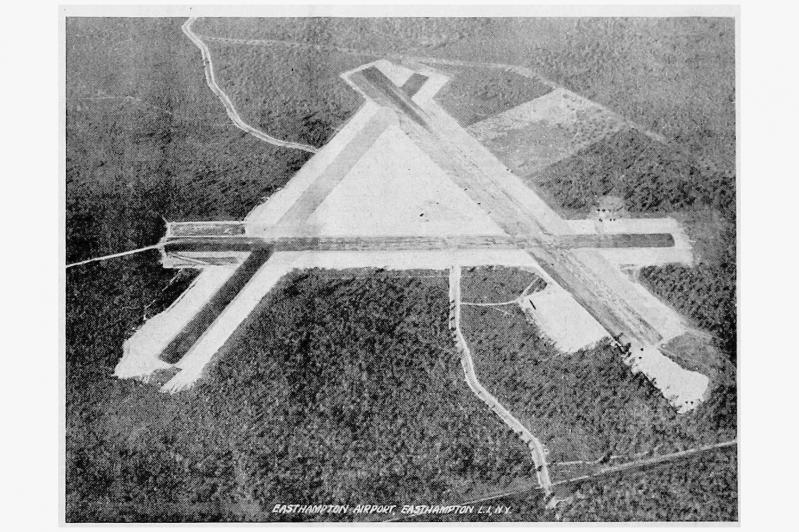While people tend to think about the East Hampton Airport in terms of jet and helicopter traffic and the noise it brings in the summer season, Marguerite Wolffsohn, East Hampton Town’s outgoing planning director, painted another picture of the airport in a presentation to the East Hampton Town Board on Tuesday.
“Airports, in particular, are very important refuges because of their continued grassland maintenance, and their exclusion of people and deer,” she said, and the town’s airport, “is a refuge for native plants.”
Her report on the airport’s grasslands and grassland species touched on history and botany. Ms. Wolffsohn, who will conclude her 32-year tenure with the town in just a few weeks, described the flora and fauna that have flourished in the enclosed area in Wainscott, undisturbed but for the aircraft that regularly roar in and out of the site. At the largely fenced-in site native species are able to thrive free of overbrowsing by deer or disturbance by humans, apart from twice-yearly mowing.
“Native grassland is a globally rare ecosystem,” Ms. Wolffsohn told the board, describing a “complex native ecosystem that has grown at the site” since pine barren forest was cleared in 1937 to create the airport. Before the arrival of European plant species, “native grasses and herbs grew on Long Island in openings which were created by natural fires or cleared and burned by people,” she said.
Ms. Wolffsohn displayed images of the site from the 1930s to the present, including an image published on page one of the Feb. 24, 1938, issue of The East Hampton Star, to illustrate the growth of an ecosystem teeming with multiple plant species, insects, birds, and foxes. Since its clearing and enclosure, “the land was allowed to do what it has done for thousands of years,” she said.
Polly Weigand, science and stewardship program manager for the Central Pine Barrens Joint Planning and Policy Commission, inventoried and analyzed pine barrens grassland areas on Long Island as part of her master’s thesis, Ms. Wolffsohn said, and found that they support a minimum of 60 floral, 25 invertebrate, and 8 avian species that are listed as endangered, threatened, or species of concern. “Most of the rare plant species were found in what she called non-agricultural grasslands,” Ms. Wolffsohn said. The airport site “revegetated on its own” as a non-agricultural grassland.
Seventy-seven species are found at the East Hampton Airport, 56 of them native plants, Ms. Wolffsohn said. These include Pityopsis falcata, or the rare sickle-leaved golden aster, which blooms “all over our airport” in late summer and early fall. Agalinis setacia, or the threadleaf false foxglove, is found only at the airport and on Fishers Island, she said. Lupinus perennis, or wild lupine, “used to bloom along our roadsides along with other native grassland species,” she said.
Baptisia tinctorial, or horseflyweed, provides a food source and breeding space for the frosted elfin butterfly, which is listed as threatened in New York State and is likely to become federally endangered in the future, she said.
Sixty-one of New York’s state bird, the eastern bluebird, fledged in boxes at the airport last year, Ms. Wolffsohn said, calling it the best site on the South Fork for bluebirds. “A lot of this has to do with the grassland itself. It’s a large site, and we have all those native plants thriving. They produce the insects, so there’s a lot of food for bluebirds as well.”
The grasshopper sparrow, which requires expansive grassland habitat for foraging, is also found there. Several generations of foxes live in the grassland at the airport, Ms. Wolffsohn said, and do not pose a threat to airport operations.
“It’s the rare grassland ecosystem as a whole that’s important,” the planning director said. “It’s all intertwined, and there are many parts that keep it here that are not obvious,” including both the soil and the interdependent plant species that have evolved over millenniums. “You can’t just plant a bunch of these flowers in a garden and get the same result.”
Protection from overbrowsing by deer has helped maintain the grassland, “and I hope you keep up the good work,” she told the board. “This is the largest and only grassland system owned by the Town of East Hampton, ensuring that this unique ecosystem and the biodiversity that it supports . . . extend past its management as an airport to protecting grasslands from any further degradation.”
Ms. Wolffsohn will retire at the end of this month, and Supervisor Peter Van Scoyoc applauded her work for the town on Tuesday.
“A not insignificant part of the reason this town remains so beautiful and wonderful is that the town has adopted sound planning practices,” he said. Ms. Wolffsohn, who started working for the town in 1987, “has been an integral part of the process over the last 32 years. I can’t think of a greater compliment than to take a look around our town, see how wonderful it is, and acknowledge that she’s in no small part responsible. . . . We thank you heartily.”

